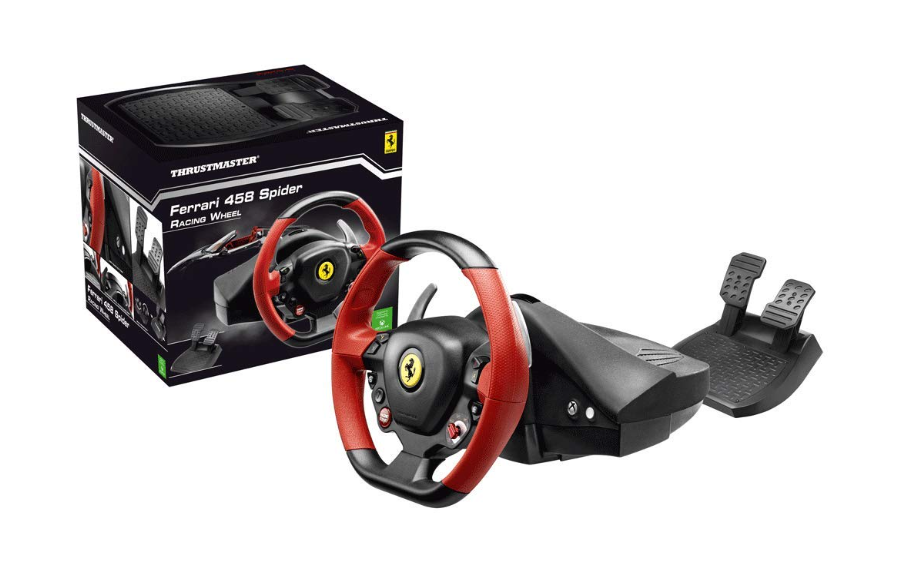
Beyond the Wheel: Rethinking Resistance, Progression, and the Future of Entry-Level Sim Racing
If you’re new to sim racing — or even if you’re a seasoned racer on a budget — chances are you’ve asked the question:
“Does the Thrustmaster Ferrari 458 Spider have force feedback?”
The short answer is no.
But maybe that’s the wrong question.
Maybe the better question is:
What kind of driver can you become without it?
In a world obsessed with realism, we often forget that racing isn’t just about feeling the road — it’s about understanding it. That’s where the 458 Spider flips the script.
What You Think You Need vs. What Actually Builds Skill
The 458 Spider doesn’t rely on force feedback motors. Instead, it uses a bungee cord-based resistance system — a design often dismissed by purists, but misunderstood in what it offers rather than what it lacks.
And what it offers is this:
- A fundamentals-first approach to sim racing
- Pure muscle memory training, without force interference
- A simplified environment that rewards cognitive learning over reactive driving
Think of it like training on weighted piano keys before you ever use the pedal. Or lifting with resistance bands instead of free weights. It’s not glamorous — but it’s pure technique building.
For anyone wondering what equipment they actually need to start sim racing, this wheel could be the smart, stripped-down dojo you’ve been overlooking.
Constraint-Led Learning: How Resistance Builds Racing IQ
There’s a concept in sports psychology called constraint-led learning. The idea? When you intentionally remove certain feedback channels (like haptic force), your brain is forced to over-develop others.
That’s exactly what happens when you race without force feedback.
Instead of reacting to motor-driven cues, you begin to rely on:
- Visual roll of the car
- Auditory clues like tire squeal and brake lockups
- On-screen telemetry data
- Cognitive pattern recognition over time
This is how drivers develop their non-haptic senses — the same kind of awareness used by Formula E engineers or drone pilots who must master performance without ever physically touching the vehicle.
If you’re curious how sim racing improves real-world driving, it’s this kind of mental modeling that carries over.
A Mental Model Machine: Why Beginners Can Actually Improve Faster
Here’s where things get weird — and cool.
Drivers who start with resistance-only wheels like the 458 Spider often improve their lap times faster in early stages. Why?
Because they’re forced to observe instead of react.
That creates a stronger mental model — a map of how the car behaves in different conditions — which leads to:
- Better consistency
- Smoother throttle/brake modulation
- Fewer bad habits from over-reliance on feedback
So instead of racing with your hands, you start racing with your brain.
This is the mindset shift we explore in our full guide to sim racing for beginners.
From Resistance to Realism: A Modular Learning Path
If you’re serious about sim racing, your journey probably looks something like this:
Phase 1: Consistency Mastery (Ferrari 458 Spider)
- Learn corner entry timing
- Train muscle memory under fixed resistance
- Build throttle discipline and brake feel cognitively
Phase 2: Feedback Adaptation (Force Feedback Wheels)
- Introduce tactile cues for understeer, curbs, weight shifts
- React in real-time with more adaptive driving style
- Choose based on your goals from our best sim racing wheels
Phase 3: Customization & Realism (Load Cell Pedals, Motion Platforms)
- Fine-tune brake pressure with load cells
- Simulate G-forces, terrain, and more
- Build your environment with a cockpit that fits your budget and space
Skip the foundation and you’re just bolting tech to poor technique. That’s why the Spider isn’t a dead end — it’s a launchpad.
What If Sim Gear Was Built to Teach, Not Just Simulate?
Imagine a hybrid entry-level wheel — one that reads your inputs, tracks your mistakes, and gradually increases resistance based on how you drive.
- Overshoot a corner? Resistance increases next lap.
- Late on throttle? Tension tightens, teaching better timing.
This is the future of accessible racing gear: tools that adapt to your learning curve, not just the track surface. And the 458 Spider may be the earliest ancestor of that future.
It’s not “less advanced.” It’s neurologically optimized.
Who Should Actually Use This Wheel?
The Thrustmaster Ferrari 458 Spider isn’t for everyone. But it’s perfect for:
Cognitive Athletes
Drivers who want to train brain-first, mechanics-later.
Minimalists & Purists
Sim racers who believe in mastering form before chasing flash.
Progression-Minded Learners
People who care more about how fast they improve than how expensive their rig looks.
This isn’t about specs. It’s about evolution.
Final Thought: Simulators Shouldn’t Just Simulate Reality—They Should Shape It
The 458 Spider doesn’t trick you into thinking you’re driving. It doesn’t offer illusions.
Instead, it becomes a mirror — reflecting your habits, your strengths, and your weak spots.
And that mirror is where growth happens.
Because not all great tools give you more…
Some teach you more by withholding what you’re not ready for.
That’s the Ferrari 458 Spider. It’s not just a wheel. It’s a training mindset.
Ready to See How It Performs on Track?
Check out our in-depth Thrustmaster Ferrari 458 Spider Review to learn how it holds up in real driving scenarios, how it compares to other entry-level wheels, and whether it’s the right starting point for your sim racing journey.
